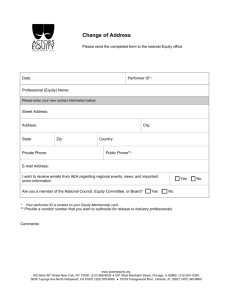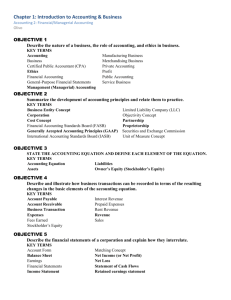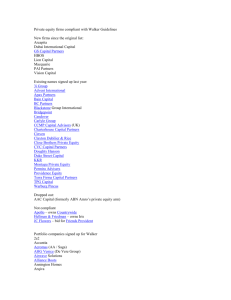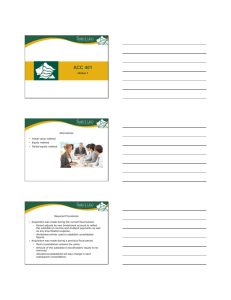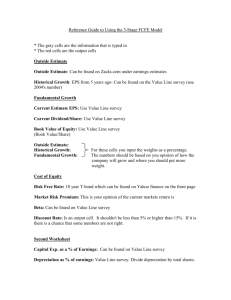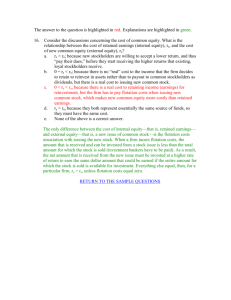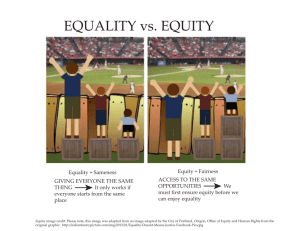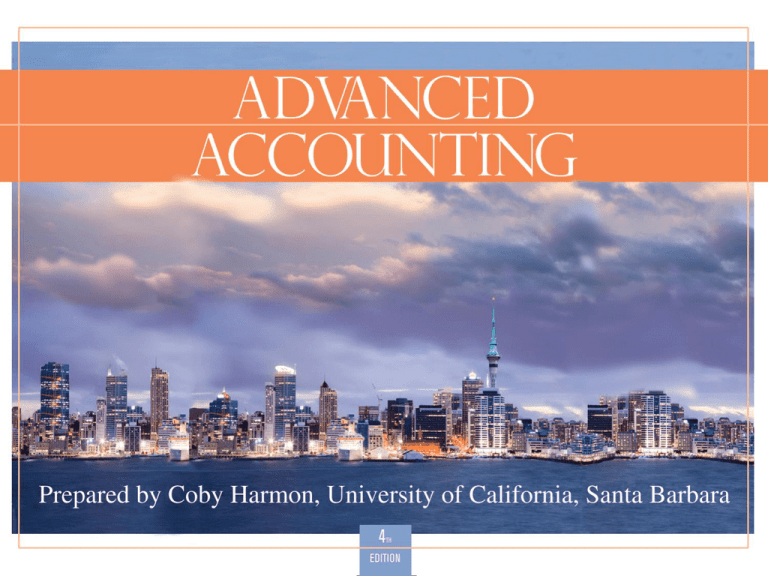
Slide
4-1
4
Consolidated Financial
Statements After Acquisition
Advanced Accounting, Fourth Edition
Slide
4-2
Learning Objectives
1.
Describe the accounting treatment required under current GAAP for varying levels of
influence or control by investors.
2. Prepare journal entries on the parent’s books to account for an investment using the
cost method, the partial equity method, and the complete equity method.
3. Understand the use of the workpaper in preparing consolidated financial statements.
4. Prepare a schedule for the computation and allocation of the difference between
implied and book values.
5. Prepare the workpaper eliminating entries for the year of acquisition (and subsequent
years) for the cost and equity methods.
6. Describe two alternative methods to account for interim acquisitions of subsidiary
stock at the end of the first year.
7. Explain how the consolidated statement of cash flows differs from a single firm’s
statement of cash flows.
8. Understand how the reporting of an acquisition on the consolidated statement of cash
flows differs when stock is issued rather than cash.
Slide
4-3
9. Describe some of the differences between U.S. GAAP and IFRS in accounting for
equity investments.
Investments in Stock
Investments in voting stock may be consolidated, or
separately reported at
cost,
fair value, or
equity.
Slide
4-4
Accounting for Investments by the Cost,
Partial Equity, and Complete Equity Methods
Ownership Percentages
0 --------------20% ------------ 50% -------------- 100%
Slide
4-5
No significant
influence
Significant
influence
(no control)
Investment
valued using
the “cost”
method but
with
adjustments
to fair value.
Investment
valued using
Equity
Method
Effective
control
Investment
valued using Cost
Method or Equity
Method
(investment
eliminated in
Consolidation)
LO 1 Varying levels of ownership are accounted for differently.
Accounting for Investments by the Cost,
Partial Equity, and Complete Equity Methods
Consolidated financial statements will be identical,
regardless of method used.
However, if the parent issues parent-only financial
statements, the complete equity method should be
used for investees over which the parent has either
significant influence or effective control.
Slide
4-6
LO 1 Varying levels of ownership are accounted for differently.
Accounting for Investments by the Cost Method
E4-1: Percy Company purchased 80% of the outstanding
voting shares of Song Company at the beginning of 2009 for
$387,000. At the time of purchase, Song Company’s total
stockholders’ equity amounted to $475,000. Income and
dividend distributions for Song Company from 2009 through
2010 are as follows:
Net income (loss)
Dividend distribution
2009
$ 63,500
25,000
2010
$ 52,500
50,000
2011
$ (55,000)
35,000
Required: Prepare journal entries for Percy Company from
the date of purchase through 2011 to account for its
investment in Song Company under each of the following
assumptions:
Slide
4-7
LO 2 Journal entries for Parent using cost method.
Accounting for Investments by the Cost Method
E4-1: A. Percy Company uses the cost method to record its
investment.
Net income (loss)
Dividend distribution
2009
2009
$ 63,500
25,000
Investment in Song
2010
$ 52,500
50,000
2011
$ (55,000)
35,000
387,000
Cash
387,000
Cash
20,000
Dividend income (.8 x $25,000)
Slide
4-8
20,000
LO 2 Journal entries for Parent using cost method.
Accounting for Investments by the Cost Method
E4-1: A. Percy Company uses the cost method to record its
investment.
Net income (loss)
Dividend distribution
2010
2009
$ 63,500
25,000
Cash
2010
$ 52,500
50,000
2011
$ (55,000)
35,000
40,000
Dividend income (.8 x $50,000)
2011
Cash
40,000
28,000
Investment in Song (.8 x $35,000)
28,000
(Liquidating dividend)
Slide
4-9
LO 2 Journal entries for Parent using cost method.
Accounting for Investments by Partial Equity
E4-1: B. Percy Company uses the partial equity method to
record its investment.
Net income (loss)
Dividend distribution
2009
2009
$ 63,500
25,000
2010
$ 52,500
50,000
Investment in Song
2011
$ (55,000)
35,000
387,000
Cash
387,000
Investment in Song
50,800
Equity income (.8 x $63,500)
Cash
50,800
20,000
Investment in Song (.8 x $25,000)
Slide
4-10
20,000
LO 2 Journal entries for Parent using partial equity method.
Accounting for Investments by Partial Equity
E4-1: B. Percy Company uses the partial equity method to
record its investment.
Net income (loss)
Dividend distribution
2010
2009
$ 63,500
25,000
2010
$ 52,500
50,000
Investment in Song
2011
$ (55,000)
35,000
42,000
Equity income (.8 x $52,500)
Cash
42,000
40,000
Investment in Song (.8 x $50,000)
Slide
4-11
40,000
LO 2 Journal entries for Parent using partial equity method.
Accounting for Investments by Partial Equity
E4-1: B. Percy Company uses the partial equity method to
record its investment.
Net income (loss)
Dividend distribution
2011
2009
$ 63,500
25,000
Equity loss (.8 x $55,000)
2010
$ 52,500
50,000
2011
$ (55,000)
35,000
44,000
Investment in Song
Cash
44,000
28,000
Investment in Song (.8 x $35,000)
Slide
4-12
28,000
LO 2 Journal entries for Parent using partial equity method.
Accounting for Investments by Complete Equity
E4-1: C. Percy Company uses the complete equity method
to record its investment. The difference between book value
of equity acquired and the value implied by the purchase price
was attributed solely to an excess of market over book values
of depreciable assets, with a remaining life of 10 years.
Net income (loss)
Dividend distribution
2009
$ 63,500
25,000
2010
$ 52,500
50,000
2011
$ (55,000)
35,000
The complete equity method is usually required to report
common stock investments in the 20% to 50% range, assuming
the investor has the ability to exercise significant influence
and does not have effective control over the investee.
Slide
4-13
LO 2 Journal entries for Parent using complete equity method.
Accounting for Investments by Complete Equity
E4-1: C. Percy Company uses the complete equity method
to record its investment.
Net income (loss)
Dividend distribution
2009
2009
$ 63,500
25,000
2010
$ 52,500
50,000
Investment in Song
2011
$ (55,000)
35,000
387,000
Cash
Investment in Song
387,000
50,800
Equity income (.8 x $63,500)
Cash
50,800
20,000
Investment in Song (.8 x $25,000)
Slide
4-14
20,000
LO 2 Journal entries for Parent using complete equity method.
Accounting for Investments by Complete Equity
E4-1: C. Percy Company uses the complete equity method
to record its investment.
A journal entry is required to adjust for depreciation related
to the excess of market over book values of depreciable
assets.
Cost of investment
Book value acquired ($475,000 x 80%)
Difference between Cost and Book value
2009
Equity income ($7,000 / 10 yrs.)
Investment in Song
Slide
4-15
$387,000
380,000
$ 7,000
700
700
LO 2 Journal entries for Parent using complete equity method.
Accounting for Investments by Complete Equity
E4-1: C. Percy Company uses the complete equity method
to record its investment.
Net income (loss)
Dividend distribution
2010
2009
$ 63,500
25,000
2010
$ 52,500
50,000
Investment in Song
2011
$ (55,000)
35,000
42,000
Equity income (.8 x $52,500)
Cash
42,000
40,000
Investment in Song (.8 x $50,000)
Equity income ($7,000 / 10 yrs.)
Investment in Song
Slide
4-16
40,000
700
700
LO 2 Journal entries for Parent using complete equity method.
Accounting for Investments by Complete Equity
E4-1: C. Percy Company uses the complete equity method
to record its investment.
Net income (loss)
Dividend distribution
2011
2009
$ 63,500
25,000
Equity Loss (.8 x $55,000)
2010
$ 52,500
50,000
2011
$ (55,000)
35,000
44,000
Investment in Song
Cash
44,000
28,000
Investment in Song (.8 x $35,000)
Equity income ($7,000 / 10)
Investment in Song
Slide
4-17
28,000
700
700
LO 2 Journal entries for Parent using complete equity method.
Consolidated Statements After Acquisition
On the date of acquisition, the only relevant financial
statement is the consolidated balance sheet.
After acquisition, a complete set of consolidated financial
statements must be prepared for the affiliated group:
Slide
4-18
Income statement,
Retained earnings statement,
Balance sheet, and
Statement of cash flows
LO 3 Use of workpapers.
Consolidated Statements After Acquisition
Year of Acquisition—Cost Method
P4-8: On January 1, 2010, Parker Company purchased 95% of the
outstanding common stock of Sid Company for $160,000. At that
time, Sid’s stockholders’ equity consisted of common stock,
$120,000; other contributed capital, $10,000; and retained
earnings, $23,000.
Required:
A. Prepare a consolidated statements workpaper on Dec. 31, 2010.
B. Prepare a consolidated statements workpaper on Dec. 31, 2011.
Slide
4-19
LO 3 Use of workpapers.
Consolidated Statements After Acquisition
P4-8: Begin the consolidating process by preparing a Computation
and Allocation Schedule, as follows:
95%
Parent
Share
$ 160,000
5%
NCI
Share
$
8,421
100%
Total
Value
$ 168,421
Less: Book value of equity acquired:
Common stock
Other contributed capital
Retained earings
Total book value
114,000
9,500
21,850
145,350
6,000
500
1,150
7,650
120,000
10,000
23,000
153,000
Difference between implied and book value
Record new goodwill
Balance
14,650
(14,650)
-
Purchase price and implied value
$
$
771
(771)
-
$
15,421
(15,421)
-
Difference between implied and book values is
established only at the date of acquisition.
Slide
4-20
LO 4 Preparing Computation and Allocation (CAD) Schedule.
Consolidated Statements After Acquisition
P4-8: A. 2010
Year of Acquisition
On December 31, 2010,
the two companies’ trial
balances were as follows
at right:
Required A. Prepare a
consolidated statements
workpaper on December
31, 2010.
Slide
4-21
Cash
Accounts receivable
Inventory
Investment in Sid
Plant and equipment
Land
Dividends declared
Cost of goods sold
Operating expenses
Total debits
Accounts payable
Other liabilities
Common stock
Other contributed capital
Retained earnings
Sales
Dividend income
Total credits
Parker
$ 62,000
32,000
30,000
160,000
105,000
29,000
20,000
130,000
20,000
$ 588,000
Sid
$ 30,000
29,000
16,000
82,000
34,000
20,000
40,000
14,000
$ 265,000
$
$
19,000
10,000
180,000
60,000
40,000
260,000
19,000
$ 588,000
12,000
20,000
120,000
10,000
23,000
80,000
$ 265,000
LO 5 Workpapers eliminating entries.
Consolidated Statements After Acquisition
P4-8: A. 2010
Income Statement
Sales
Dividend income
Total revenue
Cost of goods sold
Other expenses
Total cost and expense
Net income
Noncontrolling interest
Net income
Year of Acquisition
Parker
$ 260,000
19,000
279,000
130,000
20,000
150,000
129,000
$ 129,000
Sid
$ 80,000
NCI
19,000
80,000
40,000
14,000
54,000
26,000
$ 26,000
Retained Earnings Statement
Retained earnings, 1/1/10
40,000
Net income
129,000
Dividends declared
(20,000)
Retained earnings, 12/31/10 $ 149,000 $
Slide
4-22
Eliminations
Debit
Credit
$
19,000
23,000
26,000
(20,000)
29,000 $
23,000
19,000
42,000
$
-
19,000
$ 19,000
$
$
1,300
1,300
Consolidated
Balances
$
340,000
340,000
170,000
34,000
204,000
136,000
(1,300)
$
134,700
1,300
(1,000)
300 $
40,000
134,700
(20,000)
154,700
LO 5 Workpapers eliminating entries.
Consolidated Statements After Acquisition
P4-8: A. 2010
Balance Sheet
Cash
Accounts receivable
Inventory
Investment in Sid
Difference (cost & book)
Plant and equipment
Land
Goodwill
Total assets
Year of Acquisition
Parker
$ 62,000
32,000
30,000
160,000
15,421
105,000
29,000
NCI
160,000
15,421
82,000
34,000
15,421
$ 418,000
Accounts payable
$
Other liabilities
Common stock
Other contributed capital
Retained earnings
Noncontrolling interest 1/1
Noncontrolling interest 12/31
Total liabilities & equity $
Slide
4-23
Sid
$ 30,000
29,000
16,000
-
Eliminations
Debit
Credit
19,000
10,000
180,000
60,000
149,000
$ 191,000
$ 12,000
20,000
120,000
10,000
29,000
$
120,000
10,000
42,000
19,000
8,421
$
418,000
$ 191,000
Consolidated
Balances
$
92,000
61,000
46,000
187,000
63,000
15,421
$
464,421
$ 202,842
$ 202,842
300
8,421
8,721
$
31,000
30,000
180,000
60,000
154,700
8,721
464,421
LO 5 Workpapers eliminating entries.
Consolidated Statements After Acquisition
Workpaper Observations
1.
Each section of the workpaper represents one of
three consolidated financial statements.
2.
Elimination of the investment account.
Common stock
120,000
Other contributed capital
10,000
Retained earnings, 1/1
23,000
Difference between Implied and Book
Noncontrolling interest in equity
Investment in Sid
Slide
4-24
15,421
8,421
160,000
LO 5 Workpapers eliminating entries.
Consolidated Statements After Acquisition
Workpaper Observations
3.
Allocation of the difference between implied and book
value:
Goodwill
15,421
Difference between Implied and Book
4.
Elimination of intercompany dividends
Dividend income
19,000
Dividends declared – Sid Company
Slide
4-25
15,421
19,000
LO 5 Workpapers eliminating entries.
Consolidated Statements After Acquisition
Workpaper Observations
5.
Noncontrolling interest in consolidated net income:
Internally generated income of Sid Company
Slide
4-26
$26,000
Noncontrolling percentage owned
5%
Noncontrolling interest in income
$ 1,300
LO 5 Workpapers eliminating entries.
Consolidated Statements After Acquisition
Workpaper Observations
6.
Consolidated retained earnings:
Parker Company’s retained earnings, 1/1
+ Parker’s income
129,000
- Dividends from Sid Company
- 19,000
+ Parker’s percentage of Sid income (95%)
Slide
4-27
$ 40,000
24,700
- Parker’s dividends declared
- 20,000
Parker Company’s retained earnings, 12/31
$154,700
LO 5 Workpapers eliminating entries.
Consolidated Statements After Acquisition
Workpaper Observations
7.
Total eliminations for all three sections are in balance.
8.
To calculate the noncontrolling interest in net assets
or equity at year-end, compute the following:
NCI at Acquisition Date
$
+ NCI share of Sid income ($26,000 x 5%)
- NCI share of Sid dividends ($20,000 x 5%)
Noncontrolling Interest in Equity
Slide
4-28
8,421
1,300
-1,000
$ 8,721
LO 5 Workpapers eliminating entries.
Consolidated Statements After Acquisition
After Year of Acquisition – Cost Method
P4-8: B. 2011
On December 31, 2011,
the two companies’ trial
balances were as follows
at right:
Required B. Prepare a
consolidated statements
workpaper on December
31, 2011.
Slide
4-29
Cash
Accounts receivable
Inventory
Investment in Sid
Plant and equipment
Land
Dividends declared
Cost of goods sold
Operating expenses
Total debits
Accounts payable
Other liabilities
Common stock
Other contributed capital
Retained earnings
Sales
Dividend income
Total credits
Parker
$ 67,000
56,000
38,000
160,000
124,000
29,000
20,000
155,000
30,000
$ 679,000
Sid
$ 16,000
32,000
48,500
80,000
34,000
20,000
52,000
18,000
$ 300,500
$
$
16,000
15,000
180,000
60,000
149,000
240,000
19,000
$ 679,000
7,000
14,500
120,000
10,000
29,000
120,000
$ 300,500
LO 5 Workpapers eliminating entries after acquisition (cost method).
Consolidated Statements After Acquisition
P4-8: B. 2011
Income Statement
Sales
Dividend income
Total revenue
Cost of goods sold
Other expenses
Total cost and expense
Net income
Noncontrolling interest
Net income
After Year of Acquisition
Parker
$ 240,000
19,000
259,000
155,000
30,000
185,000
74,000
$ 74,000
Sid
$ 120,000
NCI
19,000
120,000
52,000
18,000
70,000
50,000
$ 50,000
Retained Earnings Statement
Retained earnings, 1/1/11
149,000
Net income
74,000
Dividends declared
(20,000)
Retained earnings, 12/31/11 $ 203,000 $
Slide
4-30
Eliminations
Debit
Credit
$
19,000
29,000
50,000
(20,000)
59,000 $
29,000
19,000
48,000
$
-
$
2,500
2,500
Consolidated
Balances
$
360,000
360,000
207,000
48,000
255,000
105,000
(2,500)
$
102,500
5,700
19,000
$ 24,700
$
2,500
(1,000)
1,500 $
154,700
102,500
(20,000)
237,200
LO 5 Workpapers eliminating entries after acquisition (cost method).
Consolidated Statements After Acquisition
P4-8: B. 2011
Balance Sheet
Cash
Accounts receivable
Inventory
Investment in Sid
Difference (cost & book)
Plant and equipment
Land
Goodwill
Total assets
After Year of Acquisition
$
$
Sid
$ 16,000
32,000
48,500
-
124,000
29,000
80,000
34,000
5,700
15,421
NCI
165,700
15,421
15,421
$ 474,000
Accounts payable
$
Other liabilities
Common stock
Other contributed capital
Retained earnings
Noncontrolling interest 1/1
Noncontrolling interest 12/31
Total liabilities & equity $
Slide
4-31
$ 210,500
Consolidated
Balances
$
83,000
88,000
86,500
204,000
63,000
15,421
$
539,921
Parker
$ 67,000
56,000
38,000
160,000
Eliminations
Debit
Credit
16,000
15,000
180,000
60,000
203,000
474,000
7,000
14,500
120,000
10,000
59,000
$ 210,500
120,000
10,000
48,000
$ 214,542
24,700
8,721
$ 214,542
1,500
8,721
$ 10,221
$
23,000
29,500
180,000
60,000
237,200
10,221
539,921
LO 5 Workpapers eliminating entries after acquisition (cost method).
Consolidated Statements After Acquisition
Workpaper Observations
1. Before elimination of the investment account, a workpaper
entry is made to the investment account and Parker
Company’s beginning retained earnings to recognize
Parker’s share of the cumulative undistributed income or
loss of Sid Company from the date of acquisition to the
beginning of the current year as follows:
Investment in Sid Company
Retained earnings, 1/1
($29,000 – $23,000 )
Slide
4-32
X
.95 = $5,700
5,700
5,700
Entry to establish
Reciprocity
LO 5 Workpapers eliminating entries after acquisition (cost method).
Consolidated Statements After Acquisition
Workpaper Observations
The following workpaper entries are also made:
2. Eliminate investment in Sid Company.
3. Eliminate intercompany dividends.
4. Allocate difference between cost and book value.
5. All (100%) of Sid’s revenues, expenses, assets, and
liabilities are included in the consolidated totals. The
noncontrolling interest’s share of income and net assets
are shown as separate line items.
Slide
4-33
LO 5 Workpapers eliminating entries after acquisition (cost method).
Recording Investments – Equity Method
Equity Method
Record the investment at cost and subsequently
adjust the amount each period for
the investor’s proportionate share of the
earnings (losses) and
dividends received by the investor.
If investor’s share of investee’s losses exceeds the
carrying amount of the investment, the investor ordinarily
should discontinue applying the equity method.
Slide
4-34
LO 5 Workpaper eliminating entries (equity method).
Recording Investments – Equity Method
Example: (Equity Method) On January 1, 2010,
Pennington Corporation purchased 30% of the common
shares of Edwards Company for $180,000. During the
year, Edwards earned net income of $80,000 and paid
dividends of $20,000.
Instructions
Prepare the journal entries for Pennington to record the
purchase and any additional entries related to this
investment in Edwards Company in 2010.
Slide
4-35
LO 5 Workpaper eliminating entries (equity method).
Recording Investments – Equity Method
Example: Prepare the entries for Pennington to record the
purchase and any additional entries related to this
investment in Edwards Company in 2010.
Investment in Stock
180,000
Cash
180,000
Investment in Stock
24,000
Equity in subsidiary income ($80,000 x 30%)
Cash
6,000
Investment in Stock ($20,000 x 30%)
Slide
4-36
24,000
6,000
LO 5 Workpaper eliminating entries (equity method).
Recording Investments – Equity Method
Investment Carried at Equity—Year of Acquisition
P4-12: On January 1, 2010, Parker Company purchased 90% of
the outstanding common stock of Sid Company for $180,000. At
that time, Sid’s stockholders’ equity consisted of common stock,
$120,000; other contributed capital, $20,000; and retained
earnings, $25,000. Assume that any difference between book
value of equity and the value implied by the purchase price is
attributable to land.
Required:
A. Prepare a consolidated statements workpaper on Dec. 31, 2010.
B. Prepare a consolidated statements workpaper on Dec. 31, 2011.
Slide
4-37
LO 5 Workpaper eliminating entries (equity method).
Recording Investments – Equity Method
P4-12: Begin the consolidating process by preparing a Computation
and Allocation Schedule, as follows:
90%
Parent
Share
$ 180,000
10%
NCI
Share
$ 20,000
100%
Total
Value
$ 200,000
Less: Book value of equity acquired:
Common stock
Other contributed capital
Retained earings
Total book value
108,000
18,000
22,500
148,500
12,000
2,000
2,500
16,500
120,000
20,000
25,000
165,000
Difference between implied and book value
Allocated to land
Balance
31,500
(31,500)
-
3,500
(3,500)
-
35,000
(35,000)
-
Purchase price and implied value
$
$
$
Difference between implied and book values is
established only at the date of acquisition.
Slide
4-38
LO 5 Workpaper eliminating entries (equity method).
Recording Investments – Equity Method
P4-12: A. 2010
Year of Acquisition
On December 31, 2010,
the two companies’ trial
balances were as follows:
Required A. Prepare a
consolidated statements
workpaper on December
31, 2010.
Cash
Accounts receivable
Inventory
Investment in Sid
Plant and equipment
Land
Dividends declared
Cost of goods sold
Operating expenses
Total debits
Accounts payable
Other liabilities
Common stock
Other contributed capital
Retained earnings
Sales
Equity in subsidiary income
Total credits
Slide
4-39
Parker
$ 65,000
40,000
25,000
184,500
110,000
48,500
20,000
150,000
35,000
$ 678,000
Sid
$ 35,000
30,000
15,000
85,000
45,000
15,000
60,000
15,000
$ 300,000
$
$
20,000
15,000
200,000
70,000
55,000
300,000
18,000
$ 678,000
15,000
25,000
120,000
20,000
25,000
95,000
$ 300,000
LO 5 Workpaper eliminating entries (equity method).
Recording Investments – Equity Method
P4-12: A. 2010
Year of Acquisition
Income Statement
Parker
Sales
$ 300,000
Equity in subsidiary income
18,000
Total revenue
318,000
Cost of goods sold
150,000
Other expenses
35,000
Total cost and expense
185,000
Net income
133,000
Noncontrolling interest
Net income
$ 133,000
Sid
$ 95,000
NCI
18,000
95,000
60,000
15,000
75,000
20,000
$ 20,000
Retained Earnings Statement
Retained earnings, 1/1/10
55,000
Net income
133,000
Dividends declared
(20,000)
Retained earnings, 12/31/10 $ 168,000 $
Slide
4-40
Eliminations
Debit
Credit
$
18,000
25,000
20,000
(15,000)
30,000 $
25,000
18,000
43,000
$
-
13,500
$ 13,500
$
$
2,000
2,000
Consolidated
Balances
$
395,000
395,000
210,000
50,000
260,000
135,000
(2,000)
$
133,000
2,000
(1,500)
500 $
55,000
133,000
(20,000)
168,000
LO 5 Workpaper eliminating entries (equity method).
Recording Investments – Equity Method
P4-12: A. 2010
Balance Sheet
Cash
Accounts receivable
Inventory
Investment in Sid
Difference (cost & book)
Plant and equipment
Land
Total assets
Year of Acquisition
Parker
$ 65,000
40,000
25,000
184,500
35,000
110,000
48,500
$ 473,000
Accounts payable
$ 20,000
Other liabilities
15,000
Common stock
200,000
Other contributed capital
70,000
Retained earnings
168,000
Noncontrolling interest 1/1
Noncontrolling interest 12/31
Total liabilities & equity $ 473,000
Slide
4-41
$
Sid
35,000
30,000
15,000
-
Eliminations
Debit
Credit
85,000
45,000
$ 210,000
$
15,000
25,000
120,000
20,000
30,000
NCI
4,500
180,000
35,000
35,000
$
$
120,000
20,000
43,000
13,500
20,000
$
$ 210,000
Consolidated
Balances
$
100,000
70,000
40,000
-
$ 253,000
$ 253,000
500
20,000
20,500
$
195,000
128,500
533,500
35,000
40,000
200,000
70,000
168,000
20,500
533,500
LO 5 Workpaper eliminating entries (equity method).
Recording Investments – Equity Method
Workpaper Observations
The following workpaper entries were made:
To eliminate the account “equity in subsidiary income”
and intercompany dividends.
To eliminate the Investment account against subsidiary
equity.
To distribute the difference between implied and book
value of equity acquired.
Slide
4-42
LO 5 Workpaper eliminating entries (equity method).
Recording Investments – Equity Method
Investment Carried at Equity—After Year of Acquisition
P4-12: B. 2011
On December 31, 2011,
the two companies’ trial
balances were as follows
at right:
Required B. Prepare a
consolidated statements
workpaper on December
31, 2011.
Slide
4-43
Cash
Accounts receivable
Inventory
Investment in Sid
Plant and equipment
Land
Dividends declared
Cost of goods sold
Operating expenses
Total debits
Accounts payable
Other liabilities
Common stock
Other contributed capital
Retained earnings
Sales
Equity in subsidiary income
Total credits
Parker
$ 70,000
60,000
40,000
193,500
125,000
48,500
20,000
160,000
35,000
$ 752,000
Sid
$ 20,000
35,000
30,000
90,000
45,000
15,000
65,000
20,000
$ 320,000
$
$
16,500
15,000
200,000
70,000
168,000
260,000
22,500
$ 752,000
16,000
24,000
120,000
20,000
30,000
110,000
$ 320,000
LO 5 Workpaper eliminating entries (equity method).
Recording Investments – Equity Method
P4-12: B. 2011
After Year of Acquisition
Income Statement
Parker
Sales
$ 260,000
Equity in subsidiary income
22,500
Total revenue
282,500
Cost of goods sold
160,000
Other expenses
35,000
Total cost and expense
195,000
Net income
87,500
Noncontrolling interest
Net income
$ 87,500
Sid
$ 110,000
NCI
22,500
110,000
65,000
20,000
85,000
25,000
$ 25,000
Retained Earnings Statement
Retained earnings, 1/1/11
168,000
Net income
87,500
Dividends declared
(20,000)
Retained earnings, 12/31/11 $ 235,500 $
Slide
4-44
Eliminations
Debit
Credit
$
22,500
30,000
25,000
(15,000)
40,000 $
30,000
22,500
52,500
$
-
13,500
$ 13,500
$
$
2,500
2,500
Consolidated
Balances
$
370,000
370,000
225,000
55,000
280,000
90,000
(2,500)
$
87,500
2,500
(1,500)
1,000 $
168,000
87,500
(20,000)
235,500
LO 5 Workpaper eliminating entries (equity method).
Recording Investments – Equity Method
P4-12: B. 2011
Balance Sheet
Cash
Accounts receivable
Inventory
Investment in Sid
Difference (cost & book)
Plant and equipment
Land
Total assets
After Year of Acquisition
Parker
$ 70,000
60,000
40,000
193,500
35,000
125,000
48,500
$ 537,000
Accounts payable
$
Other liabilities
Common stock
Other contributed capital
Retained earnings
Noncontrolling interest 1/1
Noncontrolling interest 12/31
Total liabilities & equity $
Slide
4-45
Sid
$ 20,000
35,000
30,000
-
Eliminations
Debit
Credit
16,500
15,000
200,000
70,000
235,500
537,000
90,000
45,000
$ 220,000
$ 16,000
24,000
120,000
20,000
40,000
$ 220,000
NCI
9,000
184,500
35,000
Consolidated
Balances
$
90,000
95,000
70,000
-
35,000
$
$
120,000
20,000
52,500
$ 262,500
13,500
20,500
$ 262,500
1,000
20,500
$ 21,500
$
215,000
128,500
598,500
32,500
39,000
200,000
70,000
235,500
21,500
598,500
LO 5 Workpaper eliminating entries (equity method).
Interim Acquisitions of Subsidiary Stock
Revenues and expenses of the acquired company are included
with those of the acquiring company only from the date of
acquisition forward.
Two acceptable alternatives for presenting the subsidiary’s
revenue and expense items in the consolidated income
statement in the year of acquisition:
Full-year reporting alternative.
Partial-year reporting alternative.
Slide
4-46
LO 6 Two approaches for interim acquisitions.
Interim Acquisitions of Subsidiary Stock
Equity Method—Full-Year Reporting Alternative
P4-16:
Pillow Company purchased
90% of the common stock
of Satin Company on May
1, 2009, for a cash
payment of $474,000.
December 31, 2009, trial
balances for Pillow and
Satin were:
Slide
4-47
Cash
Treasury stock at cost
Investment in Satin
Plant and equipment
Cost of goods sold
Operating expenses
Dividends declares
Total debits
Accounts and notes payable
Dividends payable
Common stock
Other contributed capital
Retained earnings
Sales
Equity in subsidiary income
Total credits
Pillow
$ 390,600
510,000
1,334,000
1,261,000
484,000
$ 3,979,600
Satin
$ 179,200
32,000
562,000
584,000
242,000
60,000
$ 1,659,200
$
$
270,240
1,000,000
364,000
315,360
1,940,000
90,000
$ 3,979,600
124,000
60,000
200,000
90,000
209,200
976,000
$ 1,659,200
LO 6 Two approaches for interim acquisitions.
Interim Acquisitions of Subsidiary Stock
P4-16:
Satin Company declared a $60,000 cash dividend on December 20,
2009, payable on January 10, 2010, to stockholders of record on
December 31, 2009. Pillow Company recognized the dividend on its
declaration date. Any difference between book value and the value
implied by the purchase price relates to subsidiary land, included
in property and equipment.
Required: Prepare a consolidated statements workpaper at
December 31, 2009, assuming that Satin Company uses the fullyear reporting alternative.
Slide
4-48
LO 6 Two approaches for interim acquisitions.
Interim Acquisitions of Subsidiary Stock
P4-16: Computation and Allocation of Difference between Cost
and Book Value Acquired:
100%
10%
90%
Parent
Share
$ 474,000
Purchase price and implied value
Less: Book value of equity acquired:
Common stock
Other contributed capital
Retained earings
Treasury stock
Subsidiary income 1/1 to 5/1
Total book value
Difference between implied and book value
Allocated to land
Balance
Slide
4-49
$
NCI
Share
$ 52,667
Total
Value
$ 526,667
180,000
81,000
188,280
(28,800)
45,000
465,480
20,000
9,000
20,920
(3,200)
5,000
51,720
200,000
90,000
209,200
(32,000)
50,000
517,200
8,520
(8,520)
-
947
(947)
-
9,467
(9,467)
-
$
$
LO 6 Two approaches for interim acquisitions.
Interim Acquisitions of Subsidiary Stock
P4-16: Full-Year Reporting Alternative
Income Statement
Sales
Equity in subsidiary income
Total revenue
Cost of goods sold
Other expenses
Total cost and expense
Net income
Net income purchased
Noncontrolling interest
Net income
Pillow
$ 1,940,000
90,000
2,030,000
1,261,000
484,000
1,745,000
285,000
Satin
$ 976,000
Eliminations
Debit
Credit
90,000
976,000
584,000
242,000
826,000
150,000
45,000
$
285,000
$ 150,000
Retained Earnings Statement
Retained earnings, 1/1
Net income
Dividends declared
Retained earnings, 12/31
$
315,360
285,000
600,360
209,200
209,200
150,000
135,000
(60,000)
$ 299,200 $ 344,200
Slide
4-50
NCI
$ 135,000
$
-
54,000
$ 54,000
15,000
$ 15,000
Consolidated
Balances
$
2,916,000
2,916,000
1,845,000
726,000
2,571,000
345,000
(45,000)
(15,000)
$
285,000
15,000
(6,000)
$
9,000 $
315,360
285,000
600,360
LO 6 Two approaches for interim acquisitions.
Interim Acquisitions of Subsidiary Stock
P4-16: Full-Year Reporting Alternative
Balance Sheet
Current assets
Investment in Satin
Difference (cost & book)
Plant and equipment
Total assets
Pillow
Satin
$ 390,600 $ 179,200
510,000
1,334,000
562,000
$ 2,234,600 $ 741,200
Eliminations
Debit
Credit
54,000
474,000
36,000
9,467
9,467
9,467
NCI
Consolidated
Balances
$
515,800
1,905,467
$ 2,421,267
Accounts and notes payable $ 270,240 $ 124,000
$
394,240
Dividends payable
60,000
54,000
6,000
Common stock
1,000,000
200,000
200,000
1,000,000
Other contributed capital
364,000
90,000
90,000
364,000
Treasury stock
(32,000)
32,000
Retained earnings
600,360
299,200
344,200
54,000
9,000
600,360
Noncontrolling interest 1/1
47,667
47,667
Noncontrolling interest 12/31
$ 56,667
56,667
Total liabilities & equity $ 2,234,600 $ 741,200 $ 707,134 $ 707,134
$ 2,421,267
Slide
4-51
LO 6 Two approaches for interim acquisitions.
Interim Acquisitions of Subsidiary Stock
P4-17: (Data from P4-16) Partial-Year Reporting Alternative
Income Statement
Sales
Equity in subsidiary income
Total revenue
Cost of goods sold
Other expenses
Total cost and expense
Net income
Noncontrolling interest
Net income
Pillow
$ 1,940,000
90,000
2,030,000
1,261,000
484,000
1,745,000
285,000
Eliminations
Debit
Credit
Satin
$ 650,666
90,000
650,666
389,333
161,333
550,666
100,000
$
285,000
$ 100,000
Retained Earnings Statement
Retained earnings, 1/1
Net income
Dividends declared
Retained earnings, 12/31
$
315,360
285,000
600,360
259,200
259,200
100,000
90,000
(60,000)
$ 299,200 $ 349,200
Slide
4-52
NCI
$
90,000
$
-
54,000
$ 54,000
10,000
$ 10,000
Consolidated
Balances
$
2,590,666
2,590,666
1,650,333
645,333
2,295,666
295,000
(10,000)
$
285,000
10,000
(6,000)
$ 4,000 $
315,360
285,000
600,360
LO 6 Two approaches for interim acquisitions.
Interim Acquisitions of Subsidiary Stock
P4-17: (Data from P4-16) Partial-Year Reporting Alternative
Balance Sheet
Current assets
Investment in Satin
Difference (cost & book)
Plant and equipment
Total assets
Pillow
$ 390,600
510,000
1,334,000
$ 2,234,600
Accounts and notes payable $ 270,240
Dividends payable
1,000,000
Common stock
364,000
Other contributed capital
Treasury stock
600,360
Retained earnings
Noncontrolling interest 1/1
Noncontrolling interest 12/31
$ 2,234,600
Total liabilities & equity
Slide
4-53
Satin
$ 179,200
562,000
$ 741,200
$ 124,000
60,000
200,000
90,000
(32,000)
299,200
$ 741,200
Eliminations
Credit
Debit
54,000
474,000
36,000
9,467
9,467
9,467
NCI
Consolidated
Balances
515,800
$
-
$
$
54,000
200,000
90,000
349,200
$ 712,134
32,000
54,000
52,667
$ 712,134
4,000
52,667
$ 56,667
$
1,905,467
2,421,267
394,240
6,000
1,000,000
364,000
600,360
56,667
2,421,267
LO 6 Two approaches for interim acquisitions.
Consolidated Statement of Cash Flows
Peculiarities:
1.
If the statement of cash flows starts with consolidated
net income, then the noncontrolling interest is already
included and need not be added back.
2. Subsidiary dividends paid to the noncontrolling
stockholders must be included with dividends paid by the
parent company when calculating cash outflow from
financing activities.
3. Subsidiary stock acquired directly from the subsidiary
represents an intercompany cash transfer that does not
affect the total cash balance of the consolidated group.
Slide
4-54
LO 7 Peculiarities of Consolidated Statement of Cash Flows.
Consolidated Statement of Cash Flows
The preparation of the consolidated statement of cash
flows in the year of acquisition is complicated slightly
because the comparative balance sheets at the beginning
and end of the current year are dissimilar.
1. Any cash spent or received in the acquisition itself
should be reflected in the Investing activities
section.
2. Assets and liabilities of the subsidiary at the date
of acquisition must be added to those of the parent
at the beginning of the current year.
Slide
4-55
LO 8 Stock issued as Consideration in Statement of Cash Flows.
Compare U.S. GAAP and IFRS
Application of the Equity Method
Issue
Slide
4-56
U.S. GAAP
IFRS
LO 9 Differences between U.S. GAAP and IFRS.
Compare U.S. GAAP and IFRS
Application of the Equity Method
Issue
Slide
4-57
U.S. GAAP
IFRS
LO 9 Differences between U.S. GAAP and IFRS.
Compare U.S. GAAP and IFRS
Application of the Equity Method
Issue
Slide
4-58
U.S. GAAP
IFRS
LO 9 Differences between U.S. GAAP and IFRS.
Two categories:
Three-division workpaper format used in this text.
Trial balance format.
Columns are provided for the trial balances, the
elimination entries, and normally, each financial
statement to be prepared, except for the
statement of cash flows.
Slide
4-59
Two major topics require attention in addressing the
treatment of deferred income tax consequences when
the affiliates each file separate income tax returns:
1. Undistributed subsidiary income (Appendix B of
Chapter 4).
2. Elimination of unrealized intercompany profit
(discussed in the appendices to Chapters 6 and 7).
Slide
4-60
When affiliated companies elect to file one consolidated
return, the tax expense amount is computed on the
consolidated workpapers rather than on the individual
books of the parent and subsidiary.
The amount of tax expense attributed to each company is
computed from combined income and allocated back to each
company’s books.
Slide
4-61
When separate tax returns are filed, the parent company
will include dividends received from the subsidiary in its
taxable income, while the subsidiary’s reported income is
included in consolidated net income.
Thus the difference between the subsidiary’s income and
dividends paid represents a temporary difference because
eventually this undistributed amount will be realized
through future dividends or upon sale of the subsidiary.
Slide
4-62
Assume that the parent uses the cost method to account
for the investment and that both the parent and the
subsidiary file separate tax returns. This means each
company records a tax provision based on the items
reported on its individual books.
Tax consequences relating to undistributed income are not
recorded on the books of the parent company when the
investment in the subsidiary is recorded using the cost
method.
Slide
4-63
If the undistributed income is not expected to be received
as a future dividend but is expected to be realized when
the investment is sold, the undistributed income is taxed at
the capital gains rate
Slide
4-64
If the equity method is used to account for the
investment, there is a timing difference between books and
tax on the books of the parent. Equity income is reported
on the parent’s income statement while dividends are
included on the tax return.
Therefore, deferred taxes on the parent’s books must
reflect the amount of undistributed income in the
subsidiary.
Slide
4-65
Copyright
Copyright © 2011 John Wiley & Sons, Inc. All rights reserved.
Reproduction or translation of this work beyond that permitted
in Section 117 of the 1976 United States Copyright Act without
the express written permission of the copyright owner is
unlawful. Request for further information should be addressed
to the Permissions Department, John Wiley & Sons, Inc. The
purchaser may make back-up copies for his/her own use only
and not for distribution or resale. The Publisher assumes no
responsibility for errors, omissions, or damages, caused by the
use of these programs or from the use of the information
contained herein.
Slide
4-66

